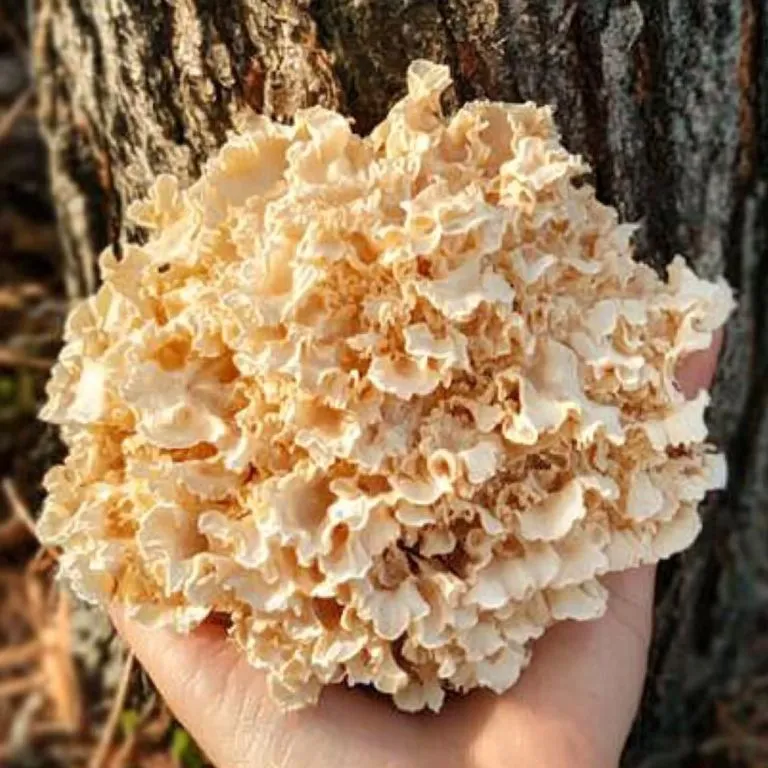I’ll never forget the day I ditched my usual market run for something way more exciting. There I was, armed with nothing but my foraging basket and a phone full of mushroom identification photos, ready to hunt down my very first cauliflower mushroom – those fascinating fungi that don’t have traditional caps but instead form clusters of wavy, leaf-like branches all connected at the base.
The early morning dew was still clinging to the grass as I wandered through Mount Hood National Forest. Pro tip: dawn is prime time for mushroom hunting when the light hits just right, and everything’s still quiet. I knew exactly where to look – these mushrooms are pine tree devotees, so I focused my search there. Some foragers even find smaller ones growing on pine stumps. After what felt like hours of searching (and probably looking like a total weirdo to the morning joggers), I spotted it – this frilly thing growing at the base of an old pine tree. It was a decent size too – these beauties can range anywhere from about 10 to 30 centimeters across, and this one was definitely on the larger end.
For the occasion, here is a trick to highlight your dishes’ flavors: getting ingredients straight from nature to your kitchen – no pit stops in the fridge – is like unlocking a cheat code for flavor.
The taste? Mind-blowing. This wasn’t just any mushroom. We’re talking about layers of nutty, earthy goodness that you just can’t get from something that’s been sitting in plastic for days. It was like the difference between instant coffee and a freshly ground cup of the good stuff.
For the first time you’d better get accompanied by someone experimenting with hunting mushrooms. You don’t want to mess around with wild mushrooms unless you’re 100% sure what you’re picking. But once you know your stuff? Pure kitchen magic, I promise.
Table of Contents
How to Choose the Perfect Cauliflower Mushrooms
- Look for Freshness:
Choose mushrooms that are firm, free from discoloration, and have a vibrant cream or beige color. Avoid those with dark spots or a slimy texture.
- Inspect the Texture:
The mushroom should feel slightly spongy but not overly soft or mushy. Its intricate folds should be intact, without signs of tearing or damage.
- Smell Test:
Fresh cauliflower mushrooms have a subtle, earthy aroma. A strong or unpleasant smell may indicate they are past their prime.
- Source Locally When Possible:
Farmers’ markets and speciality stores often carry high-quality, freshly harvested mushrooms.
How to Store Cauliflower Mushrooms
Refrigeration:
- Wrap the mushrooms loosely in a paper towel and place them in a breathable container or a paper bag.
- Store in the refrigerator’s crisper drawer to maintain freshness for up to a week.
Freezing:
- Clean and blanch the mushrooms before freezing to preserve their texture and flavor.
- Place them in an airtight container or freezer bag and store for up to three months.
Drying for Longevity:
- Dehydrate the mushrooms using a food dehydrator or an oven set to a low temperature.
- Store the dried pieces in an airtight container in a cool, dark place, and rehydrate them in water when ready to use.
Quick Tips for Handling:
- Handle the mushrooms gently to avoid damaging their delicate folds.
- If you forage for cauliflower mushrooms, clean them immediately and store them properly to maintain their quality.
By selecting and storing cauliflower mushrooms with care, you’ll ensure they remain a star ingredient in your kitchen, ready to elevate your dishes at a moment’s notice!
How to Prepare Wild Cauliflower Mushrooms
Proper preparation of these wild cauliflower mushrooms is essential to bring out their best flavour and texture while ensuring they’re clean and ready for your culinary creations. Follow these simple steps to prepare them like a pro.
Cleaning Cauliflower Mushrooms
- Step 1: Shake Off Debris
Gently shake the mushroom to remove loose dirt and debris trapped in its folds.
- Step 2: Rinse Thoroughly
Place the mushroom under cold running water, using your fingers or a soft brush to clean its intricate folds. Avoid soaking for too long, as this may affect its texture.
- Step 3: Trim the Base
Use a sharp knife to trim away the woody or tough base, leaving only the tender parts for cooking.
Tip: Pat the mushroom dry with a clean kitchen towel to prevent excess moisture during cooking.
Pre-Cooking Techniques
- Blanching for Tenderness:
- Bring a pot of salted water to a boil. Add the cleaned mushroom and blanch for 2–3 minutes.
- Drain and rinse with cold water to stop the cooking process. This step helps soften the texture and remove any residual dirt.
- Soaking for Flavor Infusion:
If desired, soak the mushroom in a marinade or broth for 10–15 minutes before cooking. This enhances its natural flavor.
Preserving Texture and Flavor
- Avoid overcooking, as it may cause the mushroom to lose its delicate structure.
- Pair with ingredients like garlic, butter, or fresh herbs to complement its mild, nutty flavor.
Cutting and Portioning
- Break the mushroom into smaller, bite-sized pieces for even cooking.
- Use your hands to separate the folds gently, or a knife for precise cuts.
Why Proper Preparation Matters
Preparing cauliflower mushrooms correctly ensures a clean, delicious, and visually appealing dish. Personally, I always follow these steps to preserve their qualities and have finally a perfect base for any recipe.
Foraging and Sourcing Cauliflower Mushrooms
Foraging for Cauliflower Mushrooms
- Where to Find:
Look for cauliflower mushrooms near the bases of conifer trees, particularly pines. They thrive in forests across North America, Europe, and Asia, typically appearing in late summer and fall.
- How to Identify:
Resemble a ruffled or curly head of cauliflower, with intricate folds and a
cream-to-beige color.
Have a mild, earthy aroma and a spongy texture.
- Foraging Tips:
Always use a reliable guidebook or forage with an experienced mushroom unter to ensure safe identification.
Carry a clean basket to avoid damaging the delicate structure of the mushrooms.
Harvest carefully by cutting the mushroom at its base, leaving part of it intact to encourage regrowth.
Safety Precautions
- Beware of Look-Alikes:
While cauliflower mushrooms are distinctive, some inedible fungi can resemble them. Double-check your identification to avoid potential risks.
- Clean Immediately:
Wild mushrooms often come with dirt or debris. Clean them as soon as possible to maintain their quality and prevent spoilage.
Sourcing Cauliflower Mushrooms
- Farmers’ Markets and Specialty Stores:
Many local farmers’ markets and specialty grocery stores stock fresh or dried cauliflower mushrooms during the season.
Speak with vendors to learn more about the mushrooms’ origin and freshness.
- Online Suppliers:
Reputable online retailers offer fresh, frozen, or dried cauliflower mushrooms.
Look for suppliers with good reviews and clear sourcing information.
- Grow Your Own:
Looking to grow your own mushrooms? Many mushroom kits are available to help you cultivate edible fungi at home. This way you will enjoy it year-round.
Whether you forage these yourself or buy them from a local market, cauliflower mushrooms are worth trying (it will surprise you:). Their unique taste and versatility make them a standout ingredient, and they’re incredibly good for you, too. Ready to give them a try? Here is a simple and easy recipe: Cauliflower Mushroom Recipe with Garlic and Herbs.


1 thought on “How to Source and Prepare Wild Cauliflower Mushrooms”